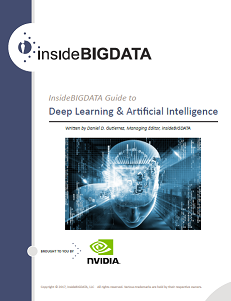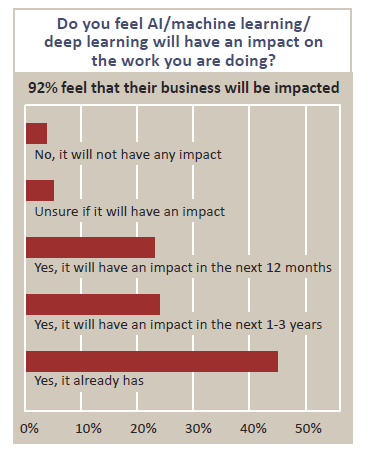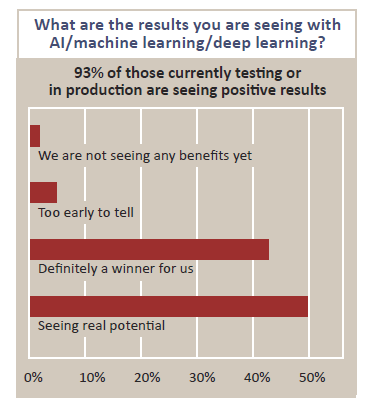The insideBIGDATA Guide to Deep Learning & Artificial Intelligence is a useful new resource directed toward enterprise thought leaders who wish to gain strategic insights into this exciting area of technology. In this guide, we take a high-level view of AI and deep learning in terms of how it’s being used and what technological advances have made it possible. We also explain the difference between AI, machine learning and deep learning, and examine the intersection of AI and HPC. We present the results of a recent insideBIGDATA survey that reflects how well these new technologies are being received. Finally, we take a look at a number of high-profile use case examples showing the effective use of AI in a variety of problem domains. The complete insideBIGDATA Guide to Deep Learning & Artificial Intelligence is available for download from the insideBIGDATA White Paper Library.
 Are AI/Machine Learning/Deep Learning in Your Company’s Future?
Are AI/Machine Learning/Deep Learning in Your Company’s Future?
In this section we’ll discuss the results of the recent “insideHPC insideBIGDATA AI/Deep Learning Survey 2016” underwritten by NVIDIA. In November 2016, insideHPC Media LLC conducted this audience survey to get readers thoughts about how they see AI, machine learning and deep learning for their own companies. Here, we’ll provide some of the survey results including numeric results, data visualization, and interpretation of the results.
The audience sample consisted of 130 readers from a wide variety of industries—21% academic/scientific research, 20% technology service provider, 18% manufacturer of technology products/software, 9% government, 6% financial/banking, 5% energy, 4% healthcare/pharma, and others.
The variety of job description also was varied—15% scientific researcher, 10% IT consultant/integrator, 9% data scientist, 9% non-IT executive management, 8% IT management, 8% data architect, 8% marketing/business analyst, 6% system admin, 5% data analyst, 5% big data engineer, and others.

State of Evaluation
The survey worked to gauge the degree to which an impact would be seen by engaging AI, machine learning and deep learning. A significant 92% felt that their business will be impacted and indicated some level of importance that AI will have on the work they’re doing, either now or in the next three years.
In terms of stage of adoption, the survey found that vast majority (98%) are evaluating or already have adopted AI, machine learning and deep learning—22% actively evaluating, 17% currently testing, 26% currently using in production, and another 33% indicated they are interested in the technology.
In terms of perceived benefit in adopting AI, machine learning and deep learning, 29% indicated they expected to more quickly turn data into knowledge and uncover patterns in large data sets to reveal new insights, 20% expected to more effectively and visualize data, 19% expected to accelerate the speed of analytics, 19% wanted to scale to turn big data into actionable knowledge, and 10% expected it would help manage the data deluge that many enterprises experience today.
When asked about what industries will see the most impact from AI, machine learning and deep learning, respondents indicated—16% healthcare, 13% finance/insurance, 11% transportation, 11% IT, 10% energy, 10% manufacturing, 10% academic research, 9% retail, 7% government, and others.
[clickToTweet tweet=”The survey found that vast majority (98%) are evaluating or already have adopted AI, machine learning, deep learning.” quote=”In terms of stage of adoption, the survey found that vast majority (98%) are evaluating or already have adopted AI, machine learning and deep learning.”]
Deployment Results
For those respondents who already have engaged AI, machine learning and deep learning, the survey found that 93% of those currently testing or in production are seeing positive results.
Readers also were asked an important question about any perceived impediments for adopting AI, machine learning and deep learning—40% indicated lack of appropriate skill-sets, 22% technology complexity, 16% trust of the technology, 10% cost is prohibitively high, and others.

Technology Perspectives
The survey also worked to uncover perspectives for how new, enabling technologies would affect the ability to adopt AI, machine learning and deep learning. For instance, 61% of respondents indicated that GPUs are having a positive impact—35% say that GPUs represent the Holy Grail for increased compute resources, and 26% believe GPUs may have at minimum a modest effect on compute resources.
HPC intersecting with AI, machine learning and deep learning. 28% of respondents felt that HPC technologies will allow them to scale computationally to build deep learning algorithms that can take advantage of high volumes of data, 25% felt that HPC techniques will allow the training of deep neural networks which tend to be computationally intensive, and 24% felt that HPC translates into machine learning progress: the faster we can train our networks, the more iterations we can make on our data sets and models, and the more iterations we make, the more we advance our machine learning.
In terms of the primary enablers and drivers for adopting AI, machine learning and deep learning, the survey found—29% said the recent surge of data such as images, text, speech has created a need to understand complex data that previously was not machine understandable and searchable, 23% said the need by data scientists and researchers to solve problems of increasing difficulty, 23% said the need to scale up computational resources to meet the demands of the large availability of data, and others.
The complete insideBIGDATA Guide to Deep Learning & Artificial Intelligence is available for download from the insideBIGDATA White Paper Library, courtesy of NVIDIA.




Speak Your Mind